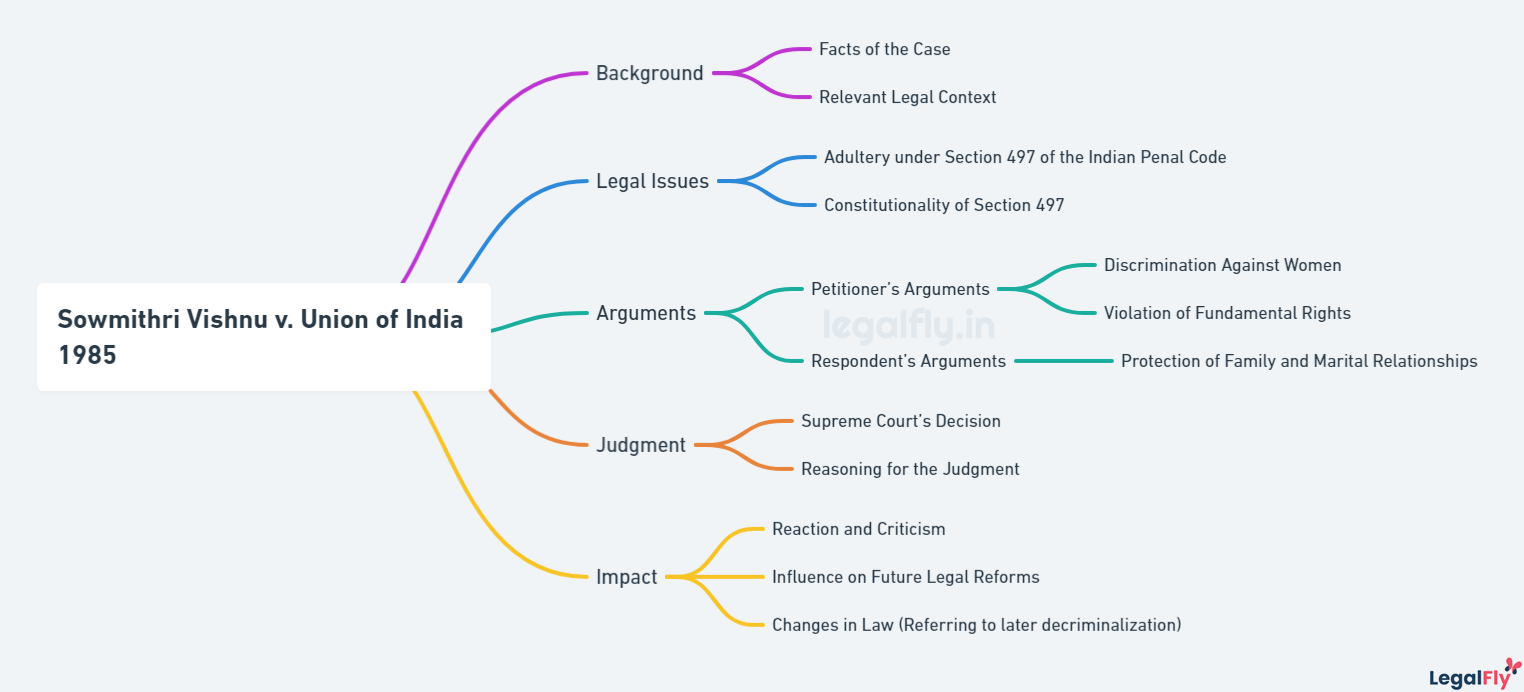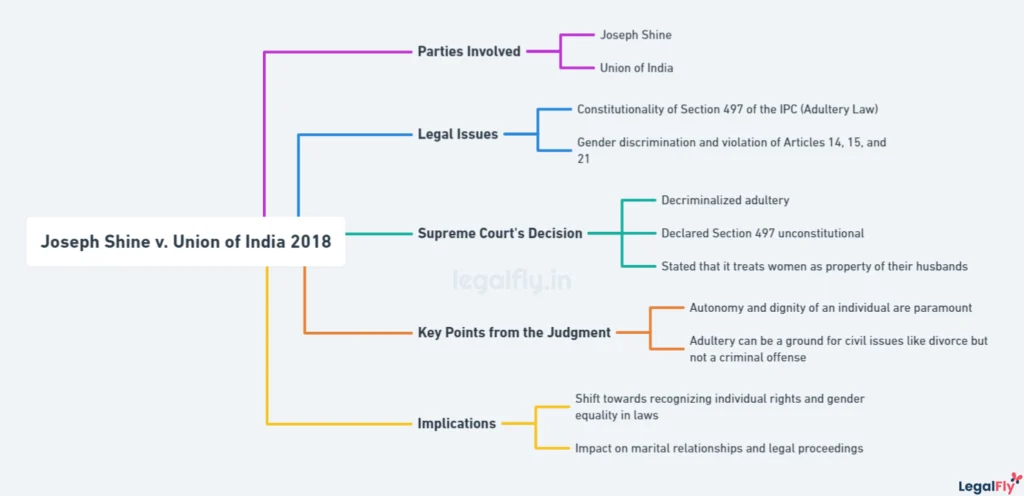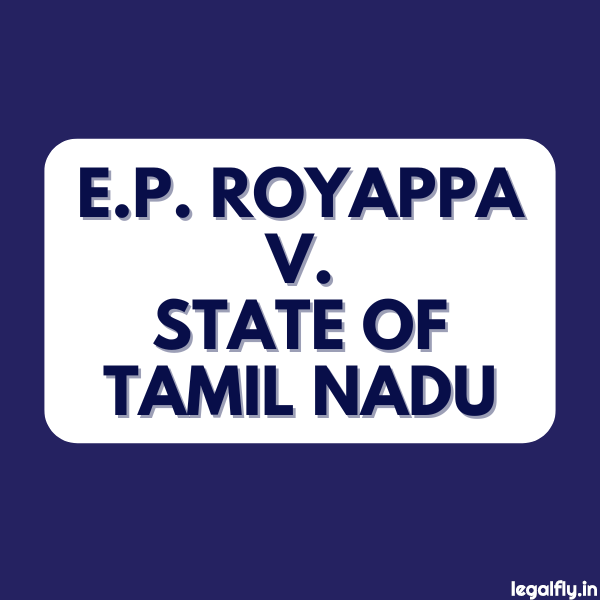Table of Contents
Case Name: Sowmithri Vishnu v. Union of India
Court: Supreme Court of India
Year: 1985
Citation: AIR 1985 SC 1618
Introduction to Sowmithri Vishnu v. Union of India
The landmark case of Sowmithri Vishnu v. Union of India was heard by the Supreme Court of India in 1985. It involved a constitutional challenge to Section 497 of the Indian Penal Code, which criminalized adultery.

The petitioner, Sowmithri Vishnu, was a school teacher from Madras (now Chennai). She filed a writ petition questioning the validity of Section 497 IPC, arguing that it discriminated against women by treating them as the property of their husbands.
The respondents were the Union of India, represented by the Attorney General. The central issue was whether Section 497 violated the fundamental rights to equality under Articles 14, 15, and 21 of the Indian Constitution.
This case gained significance as one of the earliest attempts to decriminalize adultery in India. The judgment upheld the constitutionality of Section 497, ruling that it did not discriminate against women. However, it generated debate on gender equality and liberty in marriage.
Though the law was ultimately struck down in 2018, this case marked an important milestone in challenging patriarchal notions around adultery in India. The arguments raised highlighted how criminalizing adultery could infringe constitutional safeguards against discrimination.
Background and Context
Adultery was criminalized under Section 497 of the Indian Penal Code, which made extramarital sex with a married woman without her husband’s consent a criminal offence. This colonial-era law, enacted in 1860, gave the husband exclusive rights to prosecute the man with whom his wife committed adultery.
Before the Sowmithri Vishnu case in 1985, some challenges were made to Section 497 IPC in cases like Yusuf Abdul Aziz v. State of Bombay (1954). However, the Bombay High Court upheld the constitutionality of the adultery law in that case.
In the 1980s social context, adultery was seen as a moral and social issue, and there was limited questioning of the gender bias inherent in the criminalization of only men who engaged in extramarital affairs. The Sowmithri Vishnu case emerged in this backdrop as one of the first direct challenges to the constitutionality of Section 497 IPC on grounds of discrimination.
Significance of the Case
Sowmithri Vishnu v. Union of India was one of the first legal challenges to India’s adultery law under Section 497 IPC. The case addressed important issues of gender equality and discrimination in the criminalization of adultery.
The petitioner, Sowmithri Vishnu, argued that Section 497 violated constitutional rights to equality by treating women differently than men. She contended that the law assumed women had no sexual autonomy, portraying them as helpless victims of adultery rather than equal participants.
Although the Supreme Court upheld Section 497 in 1985, Sowmithri Vishnu influenced later cases like Joseph Shine v. Union of India in 2018, where the Court struck down adultery as a criminal offence. The judgment highlighted problems with the gendered nature of adultery law that Sowmithri Vishnu first challenged over 30 years prior.

Key Facts of the Case
Section 497 of the Indian Penal Code made adultery a criminal offence. It stated that “Whoever has sexual intercourse with a person who is and whom he knows or has reason to believe to be the wife of another man, without the consent or connivance of that man, such sexual intercourse not amounting to the offense of rape, is guilty of the offense of adultery.”
The petitioner in this case was Sowmithri Vishnu, who had filed a criminal revision petition in the Madras High Court challenging the constitutionality of Section 497. She argued that the law discriminated against women by treating them as the property of their husbands and violating the principles of gender justice and equality under the law.
The criminal case arose when Sowmithri Vishnu’s husband, Vishnu, filed a case against her alleged lover under Section 497 IPC. Sowmithri Vishnu intervened and filed the revision, questioning the constitutional validity of the adultery law.
Violation of Constitutional Rights
The petitioner argued that Section 497 IPC violated constitutional rights and protections.
The challenge to Section 497 IPC
The petitioner argued that Section 497 IPC was arbitrary and gender biased and violated fundamental rights guaranteed under Articles 14, 15, and 21 of the Constitution.
Specifically, the petitioner contended that:
- Section 497 discriminated on the basis of sex as it punished only the man for adultery. The woman could not be punished even as an abettor. This was arbitrary and violated Article 14.
- The provision also took away the woman’s discretion and sexual autonomy. Treating women as passive objects without agency infringed on their dignity and the right to life and liberty under Article 21.
- Criminalizing only men for adultery deprived women of their status as legally equal citizens. It perpetuated gender stereotypes and was against gender justice.
- Further, Section 497 IPC also violated Article 15(3), which allows special provisions to be made for women and children. It discriminated against women rather than protecting them.
The petitioner argued that Section 497 was unconstitutional as it contradicted the fundamental rights to equality, liberty and dignity guaranteed under the Constitution. It sought decriminalization of adultery. This challenge formed the crux of the legal issues raised in Sowmithri Vishnu v. Union of India.
Arguments on Gender Discrimination
The adultery law under Section 497 IPC was criticized for treating women as the property of their husbands and for promoting gender stereotypes. The law only allowed a husband to prosecute the adulterer and did not give a wife the right to prosecute her adulterous husband or the woman with whom he committed adultery.
Critics argued that Section 497 assumed that wives were the property of their husbands and that adultery was an offence against the husband. The law reinforced patriarchal notions that women lacked sexual agency and their husbands controlled their sexuality. It perpetuated gender stereotypes by not recognizing women as equally autonomous individuals. Many saw Section 497 as a violation of the constitutional right to equality under Article 14.
Respondent’s Arguments
The respondent’s arguments focused on defending the adultery law and its rationale. The State justified section 497 IPC as a measure to maintain the sanctity of marriage.

They contended that decriminalizing adultery would threaten the institution of marriage and cause havoc in the domestic sphere. The State argued that the adultery law had a social justification and was aimed at prohibiting sexual relations outside marriage.
The respondent submitted that the adultery law was not discriminatory but based on intelligible differentia. They stated that women were exempted as the law viewed them as victims, not offenders in adultery. The State emphasized societal norms and the unique social conditions in India to defend section 497.
Overall, the respondent’s arguments emphasized upholding section 497 IPC by stressing its social purpose and rationale. They viewed striking down adultery law as detrimental to the institution of marriage and family values. The State justified the gender-specific nature of adultery law based on prevailing social conditions.
Court’s Decision and Rationale
In its judgment, the Supreme Court upheld the constitutionality of Section 497 of the IPC and the adultery law. The case was heard by a two-judge bench comprising Chief Justice Y.V. Chandrachud and Justice Rangnath Misra.
Delivering the verdict on behalf of the bench, Chief Justice Chandrachud interpreted Section 497 as dealing with “adultery as an offence against the sanctity of the matrimonial home.” The Court held that Section 497 does not violate Articles 14 and 15 of the Constitution, which guarantees the right to equality and prohibits discrimination on grounds of gender.
The bench reasoned that Section 497 was a “special provision” made by the legislature “in the socio-economic context of the country” and upheld its constitutionality. Citing earlier Supreme Court judgments like Yusuf Abdul Aziz and V. Revathi, the Court ruled that the adultery law was valid as it protected the institution of marriage.
The judgment attracted criticism for not striking down the gender discriminatory provisions under Section 497 that treated only men as adulterers and exempted women from prosecution for adultery. However, the Supreme Court upheld the law for preserving the sanctity of marriage and preventing it from becoming “a license for promiscuity”.
Conclusion: The Legacy of Sowmithri Vishnu v. Union of India
The 1985 case of Sowmithri Vishnu v. Union of India stands as a critical moment in the legal history of adultery in India. While the Supreme Court upheld Section 497 of the Indian Penal Code, this case ignited a crucial debate on gender equality, personal liberty, and the role of law in marital relationships.
Key takeaways from this landmark case include:
- It challenged the constitutionality of adultery law on grounds of gender discrimination.
- The case highlighted the patriarchal underpinnings of Section 497 IPC.
- Although unsuccessful, it paved the way for future legal challenges to the adultery law.
- The judgment reflected the societal norms and legal thinking of the 1980s.
What’s truly fascinating about the case of Sowmithri Vishnu is how its arguments resonated through the decades, shaping the historic 2018 judgment in Joseph Shine v. Union of India, which decriminalized adultery. This progression demonstrates the evolving nature of law and society’s changing perspectives on marriage, individual autonomy, and gender equality.
As we reflect on Sowmithri Vishnu v. Union of India, it serves as a reminder of the long journey towards gender justice in Indian law. It prompts us to question: How far have we come in addressing gender bias in our legal system? What other archaic laws might still need revisiting?
While not immediately successful, the case of Sowmithri Vishnu planted the seeds for a more equitable future. It is a testament to the power of challenging unjust laws and the importance of persistent advocacy for constitutional rights.
For those interested in Indian constitutional law, gender justice, or the evolution of social norms, Sowmithri Vishnu v. Union of India remains a fascinating case study. It offers valuable insights into the complex interplay between law, society, and individual rights.




